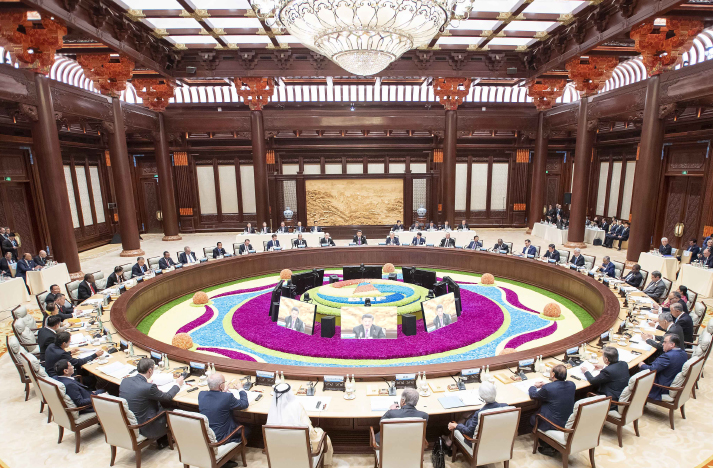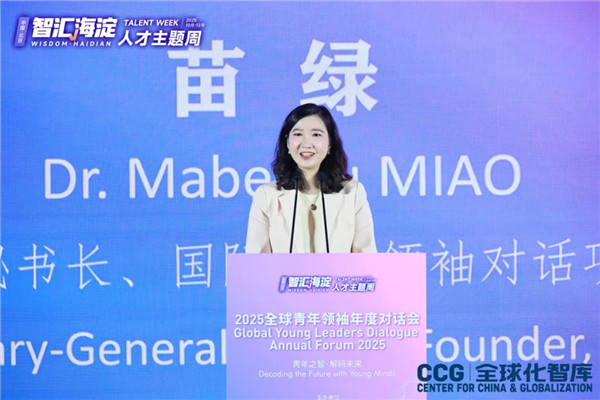Wang Huiyao: Building A Shared Future for All
January 03 , 2020
China expands diplomatic engagement with the world amid rise of protectionism.
– Wang Huiyao

The Leaders’ Roundtable of the Second Belt and Road Forum for International Cooperation is held in Beijing on April 27, 2019 (XINHUA)
The year 2019 was eventful in global affairs. It also marked the 70th founding anniversary of the People’s Republic of China (PRC). China has changed in ways unimaginable seven decades ago. It has become a leading engine of the global economy. Its citizens and companies are active all over the world. As China’s economic footprint has grown, so has its need for diplomatic engagement.
At the time of its founding in 1949, the PRC had only a fledgling diplomatic corps, and was shunned by many countries and global institutions. Today, it has forged ties with countries in every corner of the globe and plays a leading role in international organizations. Its diplomatic network has grown to 276 overseas posts, the largest in the world, according to the 2019 Lowy Global Diplomatic Index.
China has benefited greatly from economic globalization and multilateralism. However, in the new decade, we also face unprecedented threats from rising protectionism and unilateralism. Transnational challenges such as climate change, rising inequality and technological disruption are causing discontent and upheaval around the world.
Our world is increasingly interconnected and multipolar. Cooperation is the only way to address common challenges and sustain an open global economy that benefits all. In 2019, China’s diplomacy was anchored to this reality.
Ties with Europe and the U.S.
Chinese President Xi Jinping’s first and last overseas trips in 2019 took him to Europe, underscoring the importance of bilateral cooperation.
In March, Xi met with the leaders of France, Italy, Germany and the EU on a three-nation European tour. The trip saw a slew of important trade deals and cooperation agreements, with Italy becoming the first G7 nation to sign up to the Belt and Road Initiative. In April, Chinese Premier Li Keqiang visited Europe for meetings with leaders of the EU and a group of 16 Central and Eastern European Countries.
Across the Atlantic, the 40th anniversary of China-U.S. diplomatic relations proved to be testing. While negotiators sought an end to the damaging trade dispute, other channels such as Track II diplomacy helped to advance mutual understanding. For example, in May, a delegation from the Center for China and Globalization (CCG) visited the U.S. to engage with counterpart think tanks as well as politicians and industry players.
Relations in Asia
If Europe and the U.S. represent the powers that shaped the 20th century, Asia will play a central role in the story of the 21st century. As Asia prospers, it is also becoming more integrated. This is evident in China’s warming ties with key players across the continent in 2019.
Its relations with neighbors in East Asia maintained a sound development momentum. June saw two “firsts” as Xi made his first trips to the Democratic People’s Republic of Korea and Japan since assuming presidency. Ties with the Republic of Korea (ROK) also got back on track, with the resumption of top-level bilateral engagement and the trilateral China-Japan-ROK Leaders’ Meeting held in Chengdu, capital of Sichuan Province in southwest China, in December.
China continued to strengthen ties in South Asia, with Xi visiting Nepal and India in October. The relationship between China and India, the world’s two most populous countries, is destined to be one of the most important relationships of the 21st century. Xi’s meeting with Indian Prime Minister Narendra Modi in Chennai built upon the Wuhan Spirit forged in their first informal meeting in the central Chinese city of Wuhan in 2018. Following the consensus reached by Xi and Modi during the Wuhan meeting, China and India have boosted pragmatic cooperation in various fields, providing a solid foundation for sustained cooperation. The leaders of Pakistan and Bangladesh also visited China in 2019, underscoring the broad links China has built across South Asia.
China-ASEAN relations reached a new height with the implementation of the China-ASEAN Strategic Partnership Vision 2030. At the East Asia Summit in Bangkok, Thailand, in November, progress was made toward completing negotiations on the Regional Comprehensive Economic Partnership (RCEP), a trade agreement between the 10 ASEAN members and five other major trading partners in the Asia-Pacific region—China, Japan, the ROK, Australia and New Zealand. The participants aim to sign the trade agreement, which would be the world’s largest, in 2020.
Summit diplomacy
Summit diplomacy continued to be a core pillar of China’s international engagement in 2019. At a time when multilateralism was under strain, China used international events like the UN General Assembly and G20 Summit to advocate the reform and strengthening of the global governance system.
The G20 Summit in Osaka, Japan, in June brought encouraging progress as the leaders reached an agreement to eliminate marine plastic pollution. Amidst trade tensions and deadlock on other issues, this breakthrough shows that environmental protection can provide common ground for new multilateral solutions.
With progress through large global institutions hampered by a lack of consensus, select groupings and regional platforms emerged as important vectors for international cooperation. In June, Xi attended the annual summit of the eight-member Shanghai Cooperation Organization in Bishkek, Kyrgyzstan. In November, he participated in the annual BRICS Summit in Brasilia, Brazil, with the leaders of Brazil, India, Russia and South Africa.
Economic integration
In an age when trade is being weaponized and politics seems to dominate economic policy in many countries, China continues to see economic integration and mutual benefit as the foundation of lasting peace and prosperity.
The Belt and Road Initiative is the flagship of these efforts. Since the initiative was proposed in 2013, China has signed almost 200 cooperation agreements with 137 countries and 30 international organizations. In April 2019, world leaders gathered in Beijing for the Second Belt and Road Forum for International Cooperation. They mapped out a vision for the initiative as a multilateral development project adopting open, green and clean approaches.
The domestic front is also a crucial part of China’s efforts to promote economic integration with the rest of the world. Steps to open the domestic market wider continued in 2019. The Second China International Import Expo was held in Shanghai in November. The event has become a platform for further opening up, helping to increase and diversify China’s imports.
China has stepped up efforts to promote free trade around the world. In addition to pushing for the signing of the RCEP agreement, it has also worked to uphold and reform the World Trade Organization with other members.
Making China’s voice heard
In recent years, China has been more active in participating in and developing new platforms for global dialogue among governments, industry and academia. When multilateralism seems to be gridlocked, these fora offer useful supplementary channels to share views and explore solutions to cross-cutting, transnational issues.
In 2019, senior Chinese officials attended global meetings such as the Boao Forum for Asia annual conference, Munich Security Conference, World Economic Forum annual meeting, Paris Peace Forum and Bloomberg New Economy Forum in Beijing. The CCG also participated in these events, including organizing a sub-forum at the Paris Peace Forum. It proposed new solutions for global governance, highlighting the growing international role of Chinese think tanks.
The diplomatic activities in 2019 reflected just how much China’s international role had grown over the last 70 years. From bilateral engagement and multilateral institutions to Track II channels, the year showed how China’s diplomatic toolkit had evolved to deal with new challenges in a changing world.
In the new decade, with the world in flux and facing many uncertainties, China will need every part of this toolkit as it seeks to boost international cooperation and help build a shared future for humanity.







